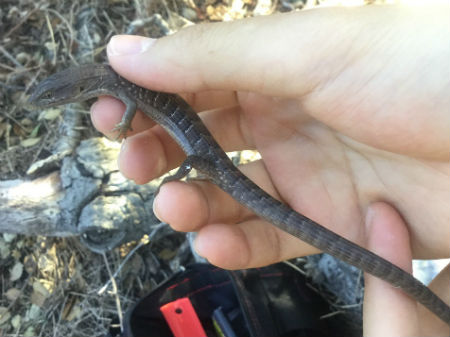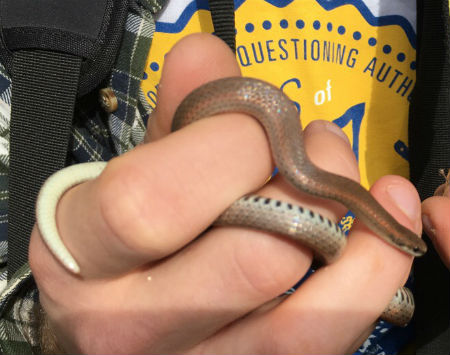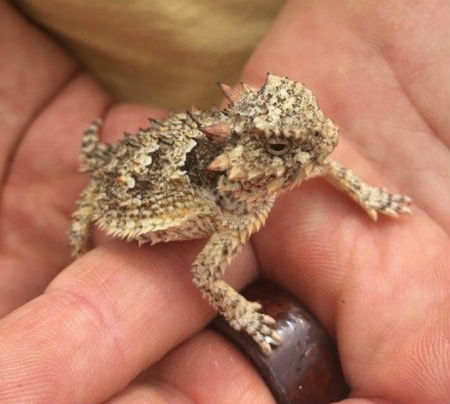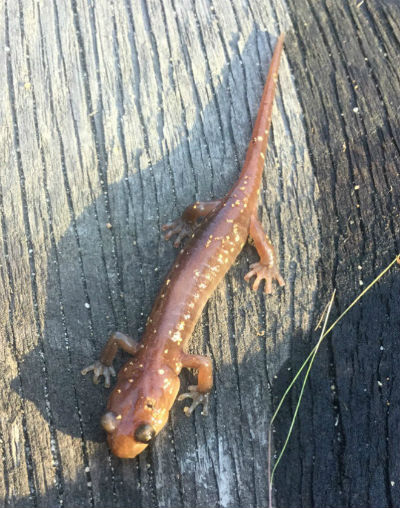FONR Herp Guide
- Size ranges 2 ¾- 5 ⅞ in (7 - 13.6 cm) from snout to vent. Appearance is of large bony scales, a large head, a slim body, long tail, and powerful jaws. Their scales are keeled on the back, sides, and legs with 14 rows of scales across the back at the middle of the body. Dorsal scales are more weakly keeled than other subspecies and their temporals are weakly keeled. The eyes are dark around the pupils and the male’s head is broader than female’s head with a more triangular shape. Colors vary from brown, grey, or olive, above, with a broad band of olive-gray to brown down the middle of the back, sometimes with spots, and darker sides mottled with a dark color. Usually, there are dark lines running lengthwise on the underside which run between the scales along their edges. Their diet consists of a variety of small invertebrates such as slugs, snails, and worms. Has also been known to eat small lizards and small mammals. Habitat ranges from woodland, forests, and grassland. Commonly found hiding under rocks, logs, boards, bark, trash, or other surface covers. An interesting fact about this reptile is that they can detach their tail from their bodies to keep predators busy while they escape.

Size ranges 2 ⅞- 7 in (7.3 - 17.8 cm) from snout to vent. Appearance is of large bony scales, a large head, a thick-rounded body, short limbs, long tail, and powerful jaws. Their scales are keeled on the back, sides, and legs with 14 rows of scales across the back at the middle of the body. The eyes are light yellow around the pupils and the male’s head is broader than female’s head with a more triangular shape. Color ranges from brown, grey, or yellowish above, with reddish blotches on the middle of the back.
Usually there are dark lines running lengthwise on the underside which run through the middle of the scales. Their diet consists of a variety of small invertebrates such as slugs, snails, and worms. Has also been known to eat small lizards and small mammals. Habitat ranges from grassland, open forests, and chaparral. Commonly found hiding under boards, logs, rocks, trash andother surface cover . An interesting fact about this reptile is that sometimes they will dive intowater and swim away to escape instead of detaching their tail.- 11.1 - 17.8 cm in length (4 ⅜ - 7 in), has small eyes and eyelids. Generally silver or beige above, yellow below. Skin looks polished. Dark brown or black individuals with yellow underparts found in several areas along California coast. Needs loose soil for burrowing, moisture, warmth, and plant cover. Frequents sparse vegetation of beaches, chaparral, pine-oak woodland, and streamside growth of sycamores, cottonwoods, and oaks. Occasionally enters desert scrub. Burrows in washes, dune sand of beaches, loose soil near slopes, and near permanent or temporary streams. Forages in leaf litter by day. May come to the surface at dusk or night. Look in leaf litter under the overhang of trees, bushes on sunny slopes and under rocks, driftwood, logs, and boards. Its diet consists of larval insects, beetles, termites, and spiders. An interesting fact about this lizard is that it is an ambush predator; waiting beneath leaf litter or a substrate before striking.
- Adult sizes range 20 - 75 in (51 - 190 cm) in length. Appearance is
of a slender snake with large eyes, a broad head and slender neck, smooth scales, and a long thin tail. Colors range from plain brown, blue-grey, or olive green to green above and unmarked off-white to yellowish below. Habitat ranges from meadows, grassland, sagebrush flats, brushy chaparral, woodlands, and forest openings. Usually prefers areas with sunny exposure. Their diet consists of lizards, small mammals, birds, eggs, snakes, small turtles, frogs, and large insects. An interesting fact about this reptile is that it has been observed eating snakes of the same species.  Adult sizes average 8 - 12 in (20.3 - 30.5 cm) in length. Appearance is
Adult sizes average 8 - 12 in (20.3 - 30.5 cm) in length. Appearance is of a small thin snake with a small head and a sharp point at the end of the tail. An adult head is typically medium to light olive-gray or brown with black flecking or blotches, occasionally with orange blotches. Dorsal coloration is rusty, brick-red, or orange-red on most adults and blends into the body color. Occasionally, the reddish coloration and dorsal stripes are not present. Its habitat is usually woodland, grassland, chaparral often near streams or water. Often encountered underneath surface objects in open grassy areas near forests, especially on sunny days after rain. Diet consists of slugs, slug eggs, and slender salamanders. An interesting fact about this reptile is that they have long teeth to allow them to hold onto slippery prey.- Adult sizes average 11 - 16 in (28 - 42 cm) in length. Appearance is
of a small thin snake with smooth scales. Coloration varies from gray, blue-gray, blackish, or dark olive dorsal coloring. The underside is usually bright orange to reddish, speckled with a few black markings and is bright reddish-orange near the tail. Also, a narrow orange band circles the neck usually 1.5 - 2.5 scale rows wide. Habitat varies from wet meadows, rocky hillsides, riparian corridors, gardens, farmland, grassland, chaparral, and woodland. Usually hides underneath rocks, boards, wood, bark, and other surface covers. Occasionally seen moving on cloudy days, at dusk, or at night. Diet consists of small salamanders, tadpoles, small frogs, small snakes, lizards, worms, slugs, and insects. An interesting fact about this reptile is that they are mildly venomous. This venom is not dangerous to humans and is used to incapacitate prey. - 76-216 cm in length (30-85 in) has two pattern types, banded and striped, with intermediate forms. Banded- dark brown or black above with 21-44 white to yellowish dorsal cross bands that extend to or onto
belly . Contrasting black and white banding may prevail in desert habitats. Some areas may have brown or dusky pigment present on scales of light crossbands. Striped- Dark brown or black above, with whitish to cream mid-dorsal stripe (often variously broken). Lateral stripes formed by a series of light-centered scales on rows 1-3 or 1-6. Usually uniformly dark or light below.Striped pattern is common in San Diego County CA. Intermediate forms- variously striped or crossbanded. Occasional individuals have light cross bands that do not exceedto belly, stop on 1st scale row leaving belly uniformly black. Other individuals may havecross bands connected along the 1st scale to form light lateral stripes, the belly is usually black. Has a variety of known habitats- woodland, swampland, coastal marshes, river bottoms, farmland, prairie, and chaparral. Primarily terrestrial, but has been known to climb. Often found near rock outcrops, clumps of vegetation, under rotting logs, old lumber, and rocks. Primarily active during morning and late afternoon, but during a hot day at night. Usually gentle but occasionallystrikes, hisses, and vibrates tail. Its diet consists of a variety of prey such as rodents, lizards, lizard eggs, snakes, snake eggs, turtle eggs and hatchlings, frogs, salamanders, birds, bird eggs and chicks, and large invertebrates. An interesting fact about this reptile is that they are immune to rattlesnake venom. - Adult size average 4.5 - 5 ft (137 - 152 cm) in length. Appearance is
of a large snake with heavily keeled scales, a narrow head that is slightly wider than the neck, and a protruding rostral scale at the tip of the snout that is bluntly rounded. Coloration is ground color, straw or tan, with large square dark chocolate blotches or saddles along the back and smaller gray spots on the sides. The back of the neck is dark brown. Its underside cream to yellowish with dark spots. Often there is reddish color on the top, especially near the tail. Usually, there is a dark stripe across the head in front of the eyes and a dark stripe from behind each eye to the angle of the jaw. Habitats range from open grasslands and brushlands, mixed woodlands, agricultural farmland, chaparral, around suburban homes and garden sheds, and riparian zones. Diet consists of mostly small mammals such as pocket gophers, moles, rabbits, and mice along with birds, bird eggsand nestlings. Has been known to eat lizards and insects. An interesting fact about this reptile is that their natural defense is to mimic a rattlesnake. They do this by elevating and inflating their body, flatten their head to a triangular shape, hiss loudly, and quickly shake their tail back and forth to make a buzzing sound. - Measured size is 18 - 43 in (46 - 109 cm) in length. Appearance is of a medium-sized slender snake with a head barely wider than the neck and keeled dorsal scales. Coloration is highly variable,
usually there is a yellow dorsal stripe and a yellowish stripe along the bottom of each side. The underside is usually yellowish to bluish-gray with varying amounts of reddish markings. On some snakes found in the Santa Cruz mountains and Monterey Bay area, the side stripes are red, with varying degrees of checkering or barring of the black on a reddish ground color. Habitats include mixed woodland, grassland, dunes, and brushland. Generally in the vicinity of ponds or flowing water. Diet is the widest of any snake species and consists of amphibians and their larvae, fish, birds, mice, lizards, snakes, worms, leeches, slugs, and snails. An interesting fact about this reptile is that they have a toxin in their saliva which can be deadly to their prey. This toxin might cause an unpleasant reaction inhumans, but is not considered dangerous to humans. - Measure size is 3.5 - 8.5 in (8.9 - 21.6 cm) in shell length. Appearance is
of a small tomedium sized turtle with a lowunkeeled carapace. Coloration is usually dark brown, olive brown, or blackish. Also has a pattern of lines or spots radiating from the centers of the scutes. The plastron lacks hinges and has 6 pairs of shields which can be cream or yellowish in color with large dark brown markings or unmarked. The legs have black speckling and may show cream to yellowish coloring. The head has a black network of spots, may show cream to yellowish coloring. Males usually have a light throat with no markings, a low-domed carapace (a flatter shell), and a concave plastron. Females usually have a throat with dark markings, a high-domed carapace (a taller shell), and a flat or convex plastron that tends to be more heavily patterned than themale’s . Habitat consists of ponds, lakes, rivers, streams, marshes, and irrigation ditches with adequate vegetation in woodlands, forests, and grasslands. Logs, rocks, and exposed banks are required for basking. Diet consists of aquatic plants, invertebrates, worms, frog and salamander eggs and larvae, crayfish, and carrion. Occasionally eats frogs and fish. This species has been listed a species of special concern by the California Department of Fish and Wildlife due to habitat destruction and the introduction of invasive turtles into its habitat, the Red-eared Sliderand Painted Turtle. An interesting fact about this reptile is that it has been known to enter seawater. - Adults range .75 - 2 in (1.9 - 5.1 cm) in length from snout to vent. Appearance is of a small frog with a large head, large eyes, a slim waist, round pads on the toe tips, limited webbing between the toes, and a wide dark stripe through the middle of each eye that extends from the nostrils to the shoulders. The legs are long and slender, the skin is smooth and moist, and often there is a Y-shaped marking between the eyes. Coloration varies from green, tan, brown, gray, reddish, and cream but is most often green or brown. The underside is pale with yellow underneath the back legs and the dark eye stripe does not change. A male’s throat is darkened and wrinkled. Habitat is often far from water outside of breeding
season such as forests, woodland, chaparral, and grassland. Diet consists of a variety of invertebrates such as flying insects. An interesting fact about this amphibian is that the body color and dark markings can change color to better match the environment.  Specimens caught and released from UCSC FONR had adults range from 11 - 36 g in weight. Average horn length in adults
Specimens caught and released from UCSC FONR had adults range from 11 - 36 g in weight. Average horn length in adults range from 4.5 - 7.7mm in length. Average snout to vent length in adults ranged from 50 - 86 mm. All specimens caught were found near coastal scrub, bare ground, maritime chaparral, and annual grassland. Colors can vary from reddish, yellow, brown, or gray. They have dark blotches on their backs withlarge dark spot on the neck. Their bellies can be cream, beige, or yellow usually with dark spots. Scales on the belly are very smooth. Their diet consists mainly of ants, but have been known to consume spiders, beetles, termites, flies, honey bees, moth larvae, and grasshoppers. They are threatened by urbanization of their habitat and by non-native Argentine ants which displace the normal harvester ants in their diet. An interesting fact about this lizard is that they can spray blood out of their eyes at canine predators as a last resort.- Measured size is 2.25 - 3.5 in (5.7 - 8.9 cm) in length from snout to vent. Appearance is
of a fairly small lizard with keeled and pointed dorsal scales of equal size on the back, sides, and belly. Scales on the backs of the thighs are mostly keeled and abruptly smaller. Coloration is brown, gray, or black with blotches. Sometimes light markings on the sides of the back form irregular lines or stripes and sometimes dark blotching may form irregular bands. The rear of the limbs is yellow or orange and the sides of the belly are blue. Males have blue markings on the sides that are edged in black, a blue patch on the throat, enlargedpostanals , enlarged femoral pores, and a swollen tail base. Females have faint or absent blue markings on the belly, no blue or green coloring on the upper surfaces, and no dark bars or crescents on the back. Habitat isany open, sunny areas such as forests, woodlands, grasslands, scrub, chaparral, along waterways, and around suburban dwellings. Also require suitable perching and basking sites such as fences, walls, woodpiles, piles of rocks, and rocky outcrops. Diet consists of mostly small invertebrates such as crickets, spiders, ticks, and scorpions. Has been known to eat small lizards, even ones of the same species. An interesting fact about this reptile is that there is a special protein in its blood that kills the bacterium in ticks that are known to spread Lyme disease.  Adults range 2 ¼- 4 in (5.7 - 10.1 cm) in length from snout to vent. Appearance is
Adults range 2 ¼- 4 in (5.7 - 10.1 cm) in length from snout to vent. Appearance is of a medium sized lungless salamander, toe tips are expanded and squarish,tail is prehensile and often coiled, usually have 15 costalgrooves, and two nasolabial grooves. Coloration is brown above with small cream to yellow spots.Number of spots varies with location. The venter is creamy white and the undersides of the tail and feet are dull yellow. Males have a broader, more triangular head than females. Habitat is most moist places on land such as coastal oak woodlands. Can be found on moist, mossy rock faces, under rocks and woody debris on land, inside stumps, and in urban yards and buildings. Diet consists of a variety of small invertebrates such as millipedes, worms, snails, ants, termites, sowbugs, moths, and centipedes. Has also been known to eat slender salamanders. An interesting fact about this amphibian is that they make a high-pitched squeak when confronted by a predator.3.2-4.7 cm in length (1 ¼ - 1 ⅞ in). Appearance is
of a narrow head with a long body and tail. Its limbs are very short.Underside of tail often lighter than belly and tinged with yellow. Ventral surfaces, including midline oftail , are finely speckled with white. Dorsal stripe often present. Colors range from brick red, brown, tan, buff, or yellow. Color frequency varies with locality. Frequents grasslands (that usually have scattered trees), chaparral, woodland, forests, yards, and vacant lots in some suburban areas. Can be found under logs, boards, bark, in damp leaf litter, and rotting logs from first rainfall to beginning ofdry period in late spring or summer. Its diet consists of a variety of invertebrates such as springtails, small beetles, snails, mites, spiders, and isopods. An interesting fact about this amphibian is that they are a sit-and-wait predator, using their tongue as a projectile to catch their prey.*Note: UCSC FONR Falls within range of Batrachoseps gavilanensis: at this time individuals found on site have not been confirmed as such. Previously species had been identified at B. attenuatus.
- Adults range 1.5 - 3.2 in (3.8 - 8.1 cm) in length from snout to vent. Appearance is
of amedium sized salamander, long legs, relatively short body, 12 - 13 costal grooves, nasolabial grooves, and a rounded tail that is constricted at the base. Coloration is reddish brown to pinkish brown above, whitish below, and orange to reddish-orange on the base of the limbs. The eyes are very dark with no yellow markings. Males have longer, more slender tails thanfemales, and a shorter snout witha enlarged upper lip. Females have bodies that are usually shorter and fatter than the males. Habitat consists of moist shaded oak woodland, mixed grassland, and chaparral. Can be found under rocks, logs, other debris, especially bark that has peeled off and fallen beside logs and trees. Diet consists of a variety of invertebrates such as worms, ants, beetles, spiders, scorpions, centipedes, millipedes, sowbugs, and snails. An interesting fact about this amphibian is that there are poison glands in the tail which is enough to deter most predators. If a person gets the poison on their lips, they will experience numbness for several hours. - Measured size is 2 ⅛- 3 ⅖ in (5.4 - 8.6 cm) in length from snout to vent. Appearance is of a small skink with a slim body, small head, thick neck, small legs, and a smooth, shiny body with cycloid scales. Coloration is striped with 3 dark brown and light creamed stripes. A wide dark brown stripe, edged with black, extends from nose to tail down the middle of the back, bordered by two pale stripes which extend from the nose over the eye to the tail. Two very dark stripes extend down each side through the eyes to the tail where they extend well out onto the tail. Two more pale stripes extend below these dark stripes. The underside is pale or gray and the tail is gray or blue. Adults develop a reddish orange coloring on the side of the head, chin, tail, and sometimes the sides during
breeding season. Habitat consists of grassland, woodland, pine forests, sagebrush, and chaparral. Can be found in open sunny areas such as clearings and the edges of creeks and rivers. Diet consists of insects and other small invertebrates, especially spiders and sowbugs. An interesting fact about this reptile is that sometimes only the blue tail is seen when it dashes through leaves or grass and the blue tail is sometimes confused for a small blue snake. - Adults range 15 - 36 in (38 - 91 cm) in length. Appearance is
of a heavy-bodied pit viper with a thin neck, a large triangular head, and a rattle at the end of the tail consisting of loose interlocking hollow segments. Coloration varies to match the environment- olive green, gray, brown, golden, reddish-brown, yellowish, or tan. Has dark brown or black blotched markings usually with dark edges and light borders mark the back with corresponding blotches on the sides. Dorsal blotches mark the front ⅔ of the body, change to dark bars on the body which are well-defined and are of uniform width. The underside is pale, sometimes weakly mottled. Habitat consists of rocky hillsides, rocky stream courses, and rocky areas in grasslands, mixed woodlands, and sagebrush. Diet consists of birds, snakes, lizards, frogs, insects, mice, rats, rabbits, hares, and ground squirrels. An interesting fact about this reptile is that it is venomous and uses pits on the sides of its head to sense heat.
Northern Alligator Lizard (Elgaria coerulea)
Southern Alligator Lizard (Elgaria multicarinata)
California Legless Lizard (Anniella pulchra)
Western Yellow-bellied Racer (Coluber constrictor)
Common Sharp-tailed Snake (Contia tenuis)
Monterey Ring-necked Snake (Diadophis punctatus vandenburghi)
California Kingsnake (Lampropeltis getula californiae)
Pacific Gopher Snake (Pituophis catenifer catenifer)
Coast Gartersnake (Thamnophis elegans terrestris)
Pacific (Western) Pond Turtle (Actinemys marmorata)
Northern Pacific Treefrog (Pseudacris regilla)
Blainville’s Horned Lizard (Phrynosoma blainvillii)
Pacific Western Fence Lizard (Sceloporus occidentalis bocourtii)
Arboreal Salamander (Aneides lugubris)
Slender Salamander (Batrachoseps sp.) *
Monterey Ensatina (Ensatina eschscholtzii eschscholtzii)
Skilton’s Skink (Plestiodon skiltonianus skiltonianus)
Northern Pacific Rattlesnake (Crotalus oreganus oreganus)
Information taken from Peterson Field Guides: Western Reptiles and Amphibians, Third Edition by Robert C. Stebbins and from the California herps website.
* Species not found in UCSC Fort Ord Natural Reserve. Reserve staff facilitates research on this species in nearby areas in Monterey County.
** Species has not be observed in the UCSC Fort Ord Natural Reserve. Species habitat may overlap with Southern Alligator Lizard.
This list has been compiled by Anthony Cruz, CSUMB: Environmental Studies Major, Fall 2017
